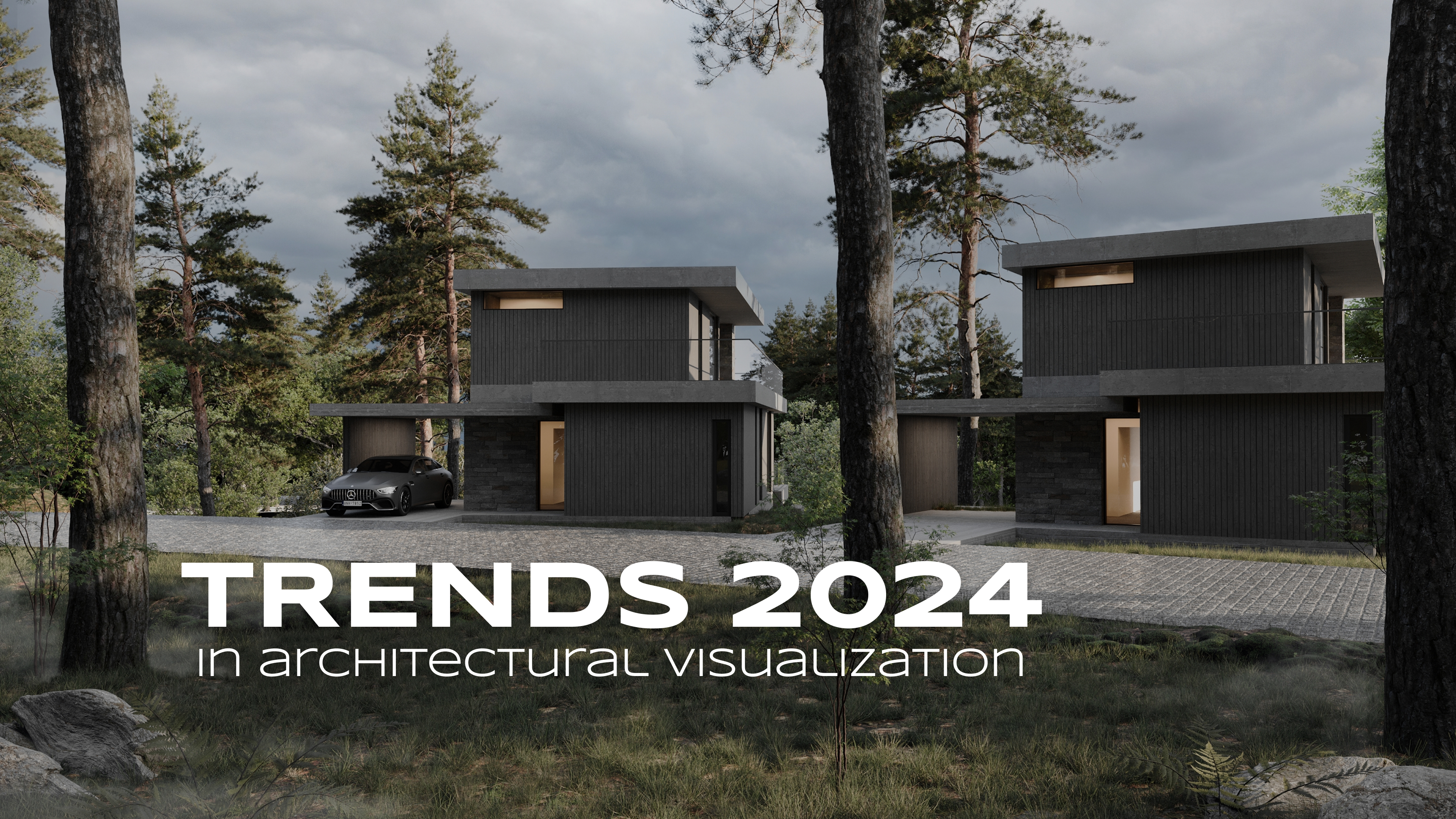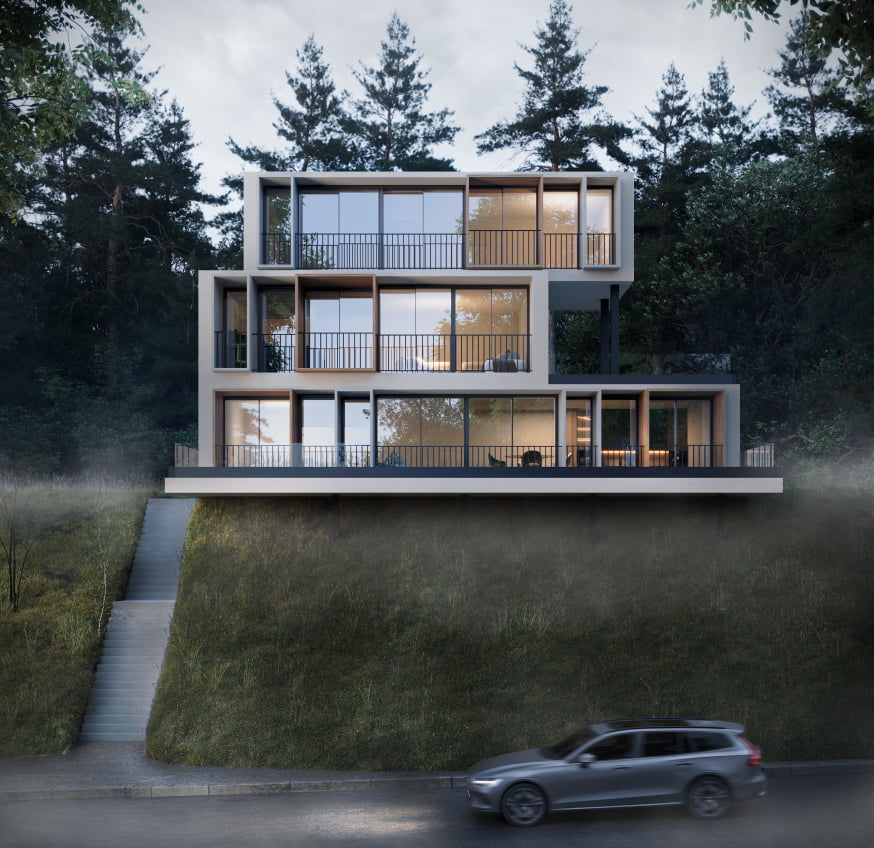Architectural visualization trends in 2024


Engage with Our Tailored Architectural Visualization Services
What could have amazed the layman in architectural visualization just a couple of years ago no longer works. Clients are becoming more demanding. They can distinguish between a poor render and one done in 4K quality.
These trends are driven by the self-awareness of the niche itself, which has been shaped under the pressure of growing competition. The maturity of the field is demonstrated not only in acquiring new powerful hardware but also in the skills of an individual 3D artist.
A consistent trend for the latter remains not only the basic knowledge acquired within university walls but also continuous improvement. Only through experimentation will fictional worlds be created that will impress users with their realism and shape a new “trendy” future. In general, we are telling you what awaits us!
Immersion in virtual reality
Immersion in virtual reality
In the rapidly evolving world innovations can lose their meaning and even effectiveness after more advanced technologies emerge the next day. Similarly, clients lose interest in static images. They crave more interactivity that will unleash a wave of new, previously unexplored emotions.
In the realm of architectural visualization virtual reality still holds strong positions and is poised to secure a lasting presence among trends for the next decade.
Virtual reality fully immerses a person in the space of their dreams offering an invaluable experience. Interactive engagement with architectural objects in real-time becomes an exhilarating journey, indistinguishable from reality with its plane tickets and compelling desires to sip a coconut cocktail on warm sands.
This technology will catch any kinesthetic person off guard with its tactile capabilities. Any interaction through virtual reality can be pivotal in the relationship between the consumer or user as the value of the offered goods or services will increase a thousandfold as will their sense of joy or surprise.
“Fast” renders
“Fast” renders
Sometimes leaving a computer at rest, which is on the verge of catching fire from wild overload is not the most effective approach when rendering new visualizations.
Today the issues of losing entire days waiting for the long-awaited “picture” are taking a back seat (there is no guarantee that one will be satisfied with the result). The new trend praises a type of rendering where 3D artists receive positive or negative (depending on the visualizer’s ideals) visual feedback from the program. They can make real-time adjustments if, for instance, the wood texture for the floor covering doesn’t match the overall tone of the room palette.
In essence, real-time rendering offers continuous bonuses: lightning-fast scene processing and the preservation of relatively high visualization quality. The key is not to overdo the level of detail to avoid compromising overall performance.
Unreal Engine and its transformative use
Unreal Engine and its transformative use
Originally designed as a game engine, Unreal Engine is just now catching the attention of 3D artists working in architectural visualization. There are currently no signs of a universal hype associated with visualizers transitioning from the “conservative” 3Ds Max workspace to the sophisticated Unreal Engine for three reasons.
The first reason is the lack of guides, reference materials or instructions adapted for any migrating 3D artist unfamiliar with programming code. This factor poses a serious obstacle that slows down the learning curve of the engine. For example, simple tasks like simulating an opening door can be leveled in the realm of 3Ds Max, but it would take weeks. In Unreal Engine, you won’t even have time to blink.
The second reason is the absence of altruists with educational materials on C++ who would undertake the task of consolidating that knowledge.
The third reason is that while many are intrigued by the wonders achieved with the engine the architectural visualization market is currently in a phase of observation rather than bold reaction to the trend.
AI assistance in post-processing
AI assistance in post-processing
A similar story unfolds here as with the exploration of the rich capabilities of Unreal Engine. The logic of AI is improving with each passing day thanks to altruists who dedicate time to its training. Currently, generative design may yield subpar results in terms of human quality assessment, accuracy in executing ideas and basic aesthetics.
However, AI tools are actively utilized by 3D artists in the post-processing stages of renders, where unforeseen defects may emerge at the last moment. Requesting their “fixing” has become routine for AI allowing it to process data swiftly and competently handle the task overall.
Animation as a form of interaction
Animation as a form of interaction
There are car configurators where you can change the body color. Interior design studio websites employ cutting-edge technologies that showcase multiple layouts of a future apartment with a single click for their clients. Such engaging interaction through animation is possible when you have programmers on your team. Yes, it all comes back to Unreal Engine, which offers a myriad of possibilities for various types of interaction.
By donning virtual reality glasses a user can utilize the day and night shift feature. By dragging a slider they can understand the overall lighting level in their interior, for instance. They can also evaluate whether they prefer stucco finish on walls or opt for wallpaper. Space animation resolves these questions even before the project is handed over for renovation.
Well-written “script”
Well-written “script”
In architectural visualization, composition remains a key and constant thesis. With this simple yet fundamental category, a 3D visualizer not only creates a flat image from volumetric shapes but imbues their projects with meaning and elaborate storytelling underlying a visual concept.
The lines of architectural high-rise buildings help orient our brains in space. Thoughtfully selected angles highlight a glass-clad luxurious office against the backdrop of a dynamic and bustling city, which seems secondary with its inhabitants. The proper proportions of villas standing peacefully on the shore organize the frame. Luxurious hotels can loop the plot and spin our heads if viewed from above. Symmetry in visualizations indicates the strictness of the subtext while introducing a sense of balance. Contrasts, on the other hand, catch the eye urging focus on the most important object in the scene, such as a kitchen decor element that creates a cozy atmosphere. All these composition techniques remain a trend for 3D artists, especially those who create visualizations based on a “script.”
The motif of ecology in renders
The motif of ecology in renders
The theme of resource conservation and the environment is so loud and poignant that it is now expressed not only in major headlines of global publications. Current issues of sustainable development concern 3D artists, who narrate them through the same well-thought-out “scripts” in their visualizations.
There are numerous projects focused on the issue of responsible treatment of nature. They present visualizations of cultural center buildings drawing attention not to smooth lines and whimsical forms of structures but to hundreds of hectares of “greenery.”
There is also a rich history in works that perceive the depletion of the planet as a challenge. In these projects, 3D artists employ their best knowledge and skills to address this common ailment.
For example, in our portfolio there is a place for one such project. A series of renders titled “Resting Reef” tells the story of reviving the memory of deceased loved ones in the “other” life.
Artificially created corals containing the ashes of the departed and crushed oyster shells give the right to a second life to the inhabitants of the marine environment. Constructions placed on the ocean floor become a new home and contribute to the increase in the population of certain species. Moreover, they are an important source of oxygen enrichment in the atmosphere!
Such works can unite all of humanity around an important theme and draw their attention to conscious consumption of all the gifts provided by Earth.
SHARE THIS...

Connect for Custom Architectural 3D Visualization
Our other articles
Get in touch
The art of 3D visualization is our passion. We specialize in a wide range of services to bring
your ideas to life. In our arsenal, we have architectural rendering, interior visualization, 3D product visualization, 360-degree panoramas, virtual reality (VR), architectural animation, rendering
for metaverses, and many other capabilities.
If you’re looking to elevate your business with stunning visualizations, simply fill out the form below. Our team will get in touch with you shortly to kickstart work on your project. Let’s collaborate to create visualizations that will amaze your clients and help you achieve your goals.
Contact us







